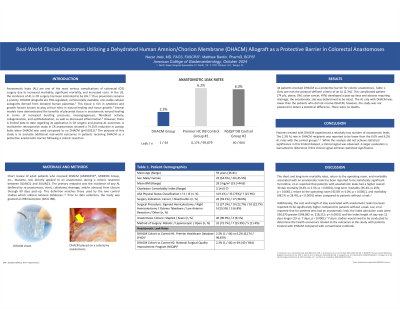Monday Poster Session
Category: Colon
P1951 - Real-World Clinical Outcomes Utilizing a Dehydrated Human Amnion/Chorion Membrane Allograft as a Protective Barrier Against Colorectal Anastomotic Leaks
Monday, October 28, 2024
10:30 AM - 4:00 PM ET
Location: Exhibit Hall E

Has Audio

Matthew Bardin, PharmD
STC Clinical, LLC
Tampa, FL
Presenting Author(s)
Nezar Jrebi, MD1, Matthew Bardin, PharmD2
1North Texas Surgical Specialists, PLLC, Fort Worth, TX; 2STC Clinical, LLC, Tampa, FL
Introduction: Anastomotic leaks (AL) are one of the most serious complications of colorectal (CR) surgery due to increased morbidity, significant mortality, and increased costs. In the US, the incidence of AL in CR surgery has been estimated to be 6%,1,2 thus prevention remains a priority. DHACM allografts are FDA-regulated, commercially available, non-viable cellular autografts derived from donated human placentas.3 This tissue is rich in cytokines and growth factors known to play critical roles in wound healing and tissue growth.4 Animal models have demonstrated the benefits of placental tissue in anastomotic wound healing in terms of increased bursting pressures, neoangiogenesis, fibroblast activity, collagenization, and epithelialization, as well as decreased inflammation.5 However, there is limited data to date regarding its application in humans for AL. The purpose of this study is to evaluate real-world outcomes in patients receiving DHACM as a protective anastomotic barrier following a colonic resection.
Methods: Chart review of adult patients who received DHACM directly applied to an anastomosis during a colonic resection between 01JAN22 and 30JUN23. The primary endpoint was the incidence of any AL (defined by reanastomosis, stent, colostomy, drainage, and/or abscess) from closure through 90 days post-op. This definition matches those used by the two control studies which utilized national databases.1,2 Prior to data collection, the study was granted an IRB Exemption (WCG IRB).
Results: 44 patients received DHACM as a protective barrier for colonic anastomosis, Table 1. Only one met the protocol-defined criteria of an AL (2.3%). This complicated patient (74 y/o, obese, DM, colon cancer, HTN) developed a post-op ileus and abscess requiring drainage, the anastomotic site was determined to be intact. There were no deaths.
Discussion: The current data highlights with DHACM a 62% relative risk reduction in protocol-defined AL is observed compared to historical controls. This mirrors a 2017 study that reported a 1% AL rate in patients receiving DHACM for CR anastomoses.6 Larger multi-centered studies are warranted to confirm these findings and the overall applicability of DHACM in CR surgery.
References:
Note: The table for this abstract can be viewed in the ePoster Gallery section of the ACG 2024 ePoster Site or in The American Journal of Gastroenterology's abstract supplement issue, both of which will be available starting October 27, 2024.
Disclosures:
Nezar Jrebi, MD1, Matthew Bardin, PharmD2. P1951 - Real-World Clinical Outcomes Utilizing a Dehydrated Human Amnion/Chorion Membrane Allograft as a Protective Barrier Against Colorectal Anastomotic Leaks, ACG 2024 Annual Scientific Meeting Abstracts. Philadelphia, PA: American College of Gastroenterology.
1North Texas Surgical Specialists, PLLC, Fort Worth, TX; 2STC Clinical, LLC, Tampa, FL
Introduction: Anastomotic leaks (AL) are one of the most serious complications of colorectal (CR) surgery due to increased morbidity, significant mortality, and increased costs. In the US, the incidence of AL in CR surgery has been estimated to be 6%,1,2 thus prevention remains a priority. DHACM allografts are FDA-regulated, commercially available, non-viable cellular autografts derived from donated human placentas.3 This tissue is rich in cytokines and growth factors known to play critical roles in wound healing and tissue growth.4 Animal models have demonstrated the benefits of placental tissue in anastomotic wound healing in terms of increased bursting pressures, neoangiogenesis, fibroblast activity, collagenization, and epithelialization, as well as decreased inflammation.5 However, there is limited data to date regarding its application in humans for AL. The purpose of this study is to evaluate real-world outcomes in patients receiving DHACM as a protective anastomotic barrier following a colonic resection.
Methods: Chart review of adult patients who received DHACM directly applied to an anastomosis during a colonic resection between 01JAN22 and 30JUN23. The primary endpoint was the incidence of any AL (defined by reanastomosis, stent, colostomy, drainage, and/or abscess) from closure through 90 days post-op. This definition matches those used by the two control studies which utilized national databases.1,2 Prior to data collection, the study was granted an IRB Exemption (WCG IRB).
Results: 44 patients received DHACM as a protective barrier for colonic anastomosis, Table 1. Only one met the protocol-defined criteria of an AL (2.3%). This complicated patient (74 y/o, obese, DM, colon cancer, HTN) developed a post-op ileus and abscess requiring drainage, the anastomotic site was determined to be intact. There were no deaths.
Discussion: The current data highlights with DHACM a 62% relative risk reduction in protocol-defined AL is observed compared to historical controls. This mirrors a 2017 study that reported a 1% AL rate in patients receiving DHACM for CR anastomoses.6 Larger multi-centered studies are warranted to confirm these findings and the overall applicability of DHACM in CR surgery.
References:
- Hammond, et al. J Gastrointest Surg,2014;1176.
- Turrentine, et al. J Am Coll Surg,2015;195.
- AMNIOFIX® Human Amniotic Membrane Allograft Instructions for Use.2022.
- Koob, et al. Int Wound J,2013;493.
- Uludag, et al. Int J Colorectal Dis, 2009;809.
- Ortega, et al. J Am Coll Surg,2017;e6.
Note: The table for this abstract can be viewed in the ePoster Gallery section of the ACG 2024 ePoster Site or in The American Journal of Gastroenterology's abstract supplement issue, both of which will be available starting October 27, 2024.
Disclosures:
Nezar Jrebi indicated no relevant financial relationships.
Matthew Bardin: Atea Pharma – Consultant. MiMedx Group, Inc. – Grant/Research Support. NeuroBo Pharma – Employee.
Nezar Jrebi, MD1, Matthew Bardin, PharmD2. P1951 - Real-World Clinical Outcomes Utilizing a Dehydrated Human Amnion/Chorion Membrane Allograft as a Protective Barrier Against Colorectal Anastomotic Leaks, ACG 2024 Annual Scientific Meeting Abstracts. Philadelphia, PA: American College of Gastroenterology.
